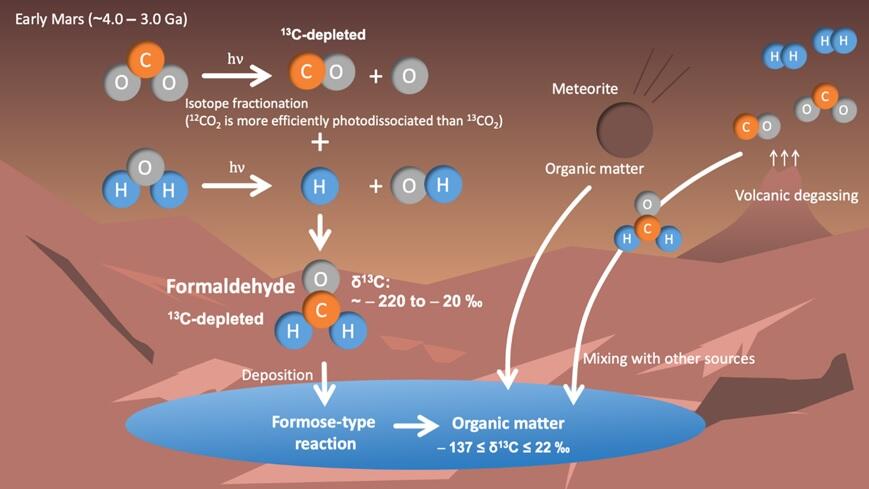It is known that the stable isotope ratios of carbon in organic matter in Martian sediments are extremely low, especially heavy carbon 13C, and that the values vary greatly from sample to sample. However, the reason for this variation is not well understood. A research group comprising Graduate Student Shungo Koyama, Research Fellow Tatsuya Yoshida, and Professor Naoki Terada in the Department of Geophysics, Graduate School of Science at Tohoku University developed an atmospheric evolution model that combines a photochemistry model of the atmosphere and a radiative-convective model to estimate the evolution of carbon isotope ratios in formaldehyde in the early Martian atmosphere. They found that the anomalous carbon isotope ratios observed in Martian organic matter can be explained by analyzing atmospheric formaldehyde. This suggests that formaldehyde may be one of the molecules responsible for the origins of Martian organic matter and further implies that molecules that are the building blocks of life, such as sugars, may have been produced on early Mars. The results of this work are published in Scientific Reports.

Provided by Shungo Koyama, Tohoku University
Today, Mars has a cold, dry environment, but geological evidence suggests that liquid water existed on Mars approximately 3-4 billion years ago. Explorations by the NASA's Mars rover Curiosity have revealed that organic matter in Martian sediments formed during that era is unusually low in 13C. Furthermore, this carbon isotope ratio varies widely from sample to sample. However, the reason for these unusual values remained a mystery.
In response to this, the research group focused on formaldehyde (H2CO), which is produced in the atmosphere. These molecules are believed to have been formed in the early Martian atmosphere. After being deposited on the ground, they are known to produce complex organic compounds in water, including sugars, the building blocks of life.
The research group developed a model of the Martian atmospheric evolution that combines a photochemistry model of the atmosphere and a radiative-convective model to estimate the evolution of carbon isotope ratios within formaldehyde in the early Martian atmosphere approximately 3-4 billion years ago. The results showed that when carbon dioxide (CO2) in the Martian atmosphere is decomposed by ultraviolet radiation from the sun, the amount of 13CO2 decomposed is less than that of 12CO2, resulting in less 13C in formaldehyde produced from carbon monoxide (CO) after CO2 decomposition.
The carbon isotope ratio varies depending on factors such as the atmospheric pressure of Mars at the time, reflectivity (albedo) of the surface, CO/CO2 ratio, and amount of hydrogen ejected from volcanoes. This formaldehyde-derived organic matter can explain the anomalous carbon isotope ratios (i.e., the depletion of 13C) found in Martian organic matter.
Considering the wide range of observed values, another characteristic of the isotope ratios of Martian organic matter, it is suggested that organic matter on Mars is formed by a mixture of not only organic matter derived from formaldehyde, but also various organic matter derived from volcanic gases and that transported by meteorites.
This finding indicates that formaldehyde has contributed to the formation of organic matter on early Mars and that molecules such as sugars, which are the building blocks of life, may have been produced on Mars. Surveys using surface-based probes are still under progress, and a more detailed picture of the characteristics of organic matter in Mars and the environment in which it has formed is emerging. In addition, a Japan-led sample-return mission from a Martian moon, "MMX (Martian Moons eXploration)" is expected to provide information on carbon isotopes from different eras of Mars.
Based on this data, the research group aims to determine "when," "how much," "where," and "from which molecules" the organic matter responsible for life was produced on Mars, thereby closing in on the possibility of life emerging on Mars.
Journal Information
Publication: Scientific Reports
Title: Stable carbon isotope evolution of formaldehyde on early Mars
DOI: 10.1038/s41598-024-71301-w
This article has been translated by JST with permission from The Science News Ltd. (https://sci-news.co.jp/). Unauthorized reproduction of the article and photographs is prohibited.




